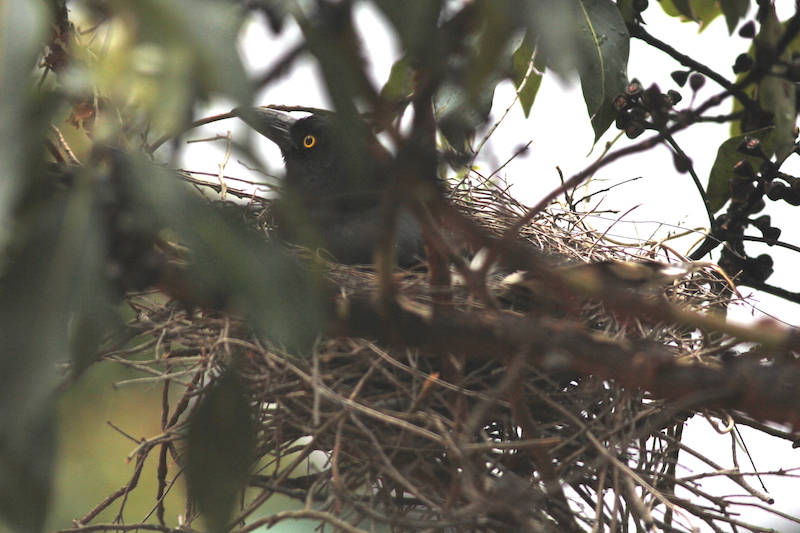UPDATED: JANUARY 5, 2025
SEPTEMBER 2024: Spring has sprung – and it is birds’ breeding season again. I’m keeping an eye out with anticipation where the resident pied currawong couple might be building their nest this year.
OCTOBER 16: I had a pleasant surprise two days after I returned from my weekend trip to Bathurst. To my delight, the female currawong has made a perfect, bowl-shaped nest in the tree right outside my top-floor apartment – not far from where her own chicks were building a ‘practice nest’ last summer. Leading up to this discovery, I’d had a very busy fortnight and hadn’t been home much, and I had absolutely no idea they were building their nest right under my nose!
At least they seem comfortable enough with my presence – they must have realized by now that I’m totally harmless. Wherever they build their nest, raising the young is always fraught with danger with any number of enemies around – and they seem to have decided to stick with ‘the devil they know’ (= me!).
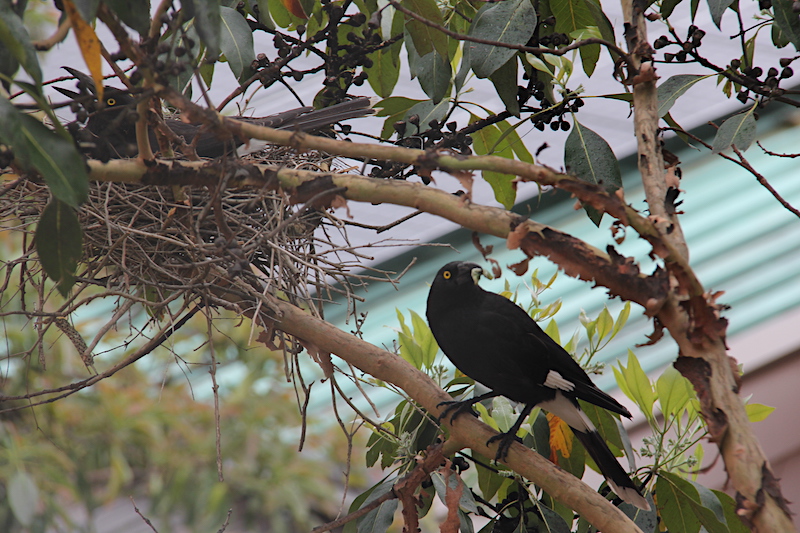
OCTOBER 18: With their nest now ready, the currawong pair began mating – but within a few hours a couple of channel-billed cuckoos appeared in the tree, sending not just the currawongs but the noisy miner family nearby into frenzy (cue Darth Vader’s Theme in the background!). Obviously, the cuckoos were on the lookout for surrogate parents that would raise their chick. But they left after a while as they realized the nest was still empty and they couldn’t lay their egg in there – or eat currawong’s eggs for lunch!
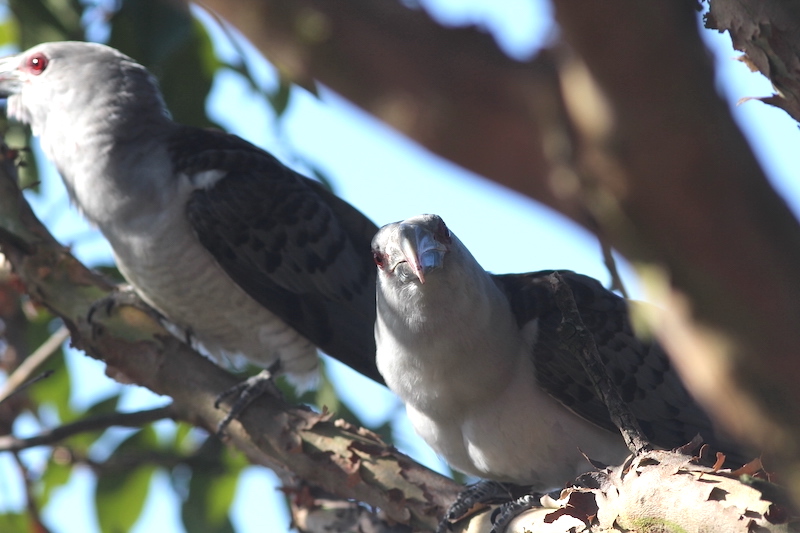
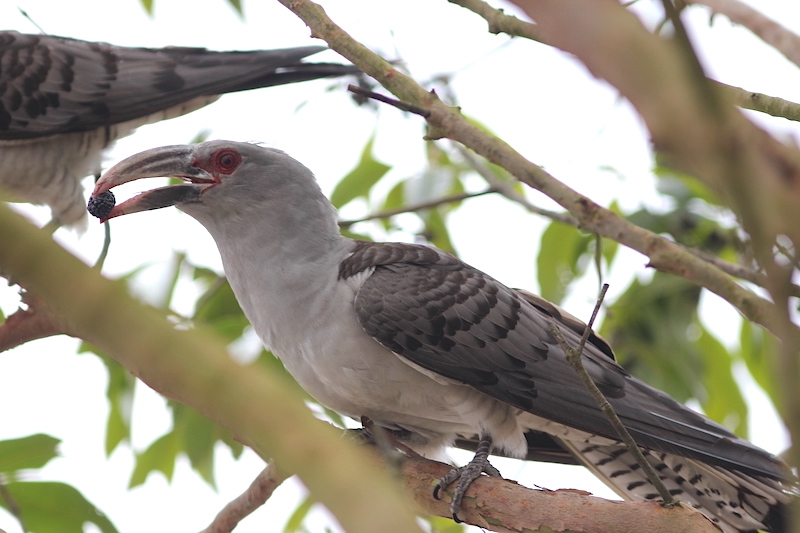
Now that the nest is ‘compromised’, the male currawong looks a bit unsure about the safety of the nest, but the female seems determined to persevere with the nest she so lovingly built.
Soon, a pattern has emerged: the currawong pair would mate, and soon enough the cuckoos would come back on a not-so-covert reconnaissance mission, then all hell would break loose with the birds in the vicinity. And this Catch-22 situation continued for about 10 days. By this stage, the female currawong is really clucky – and if they keep mating, then she’ll need to pop her eggs out somewhere eventually…
OCTOBER 27: One of the cuckoos was seen in the tree early in the morning, but the female currawong has finally bit the bullet and sat down in the nest for good: she must have laid her egg now.
For pied currawongs, it’s the female’s role to incubate the eggs, while the male feeds her during the three-week incubation period. When the male comes back with some food, the female makes a sweet little chirping sound as if she herself were a baby. But, to me, her partner is not feeding her enough, sometimes leaving her alone for hours on end.
“C’mon, Man… lift your game! She’s doing all the hard work for you!”
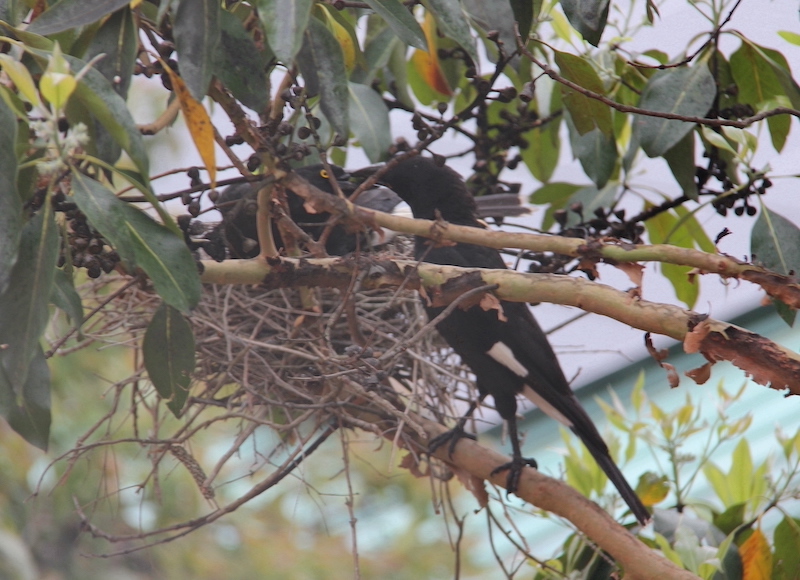
During the day, the female occasionally leaves the nest to stretch her legs (and wings) and grab some much-needed snack. I can’t quite see exactly how many eggs are in the nest, but I counted at least two of them with my eyeballs. It remains to be seen just what will emerge from the nest in three weeks’ time – whether it’s black currawong chicks or a monstrous Cuckoo Kid Ver.2 – or nothing at all!
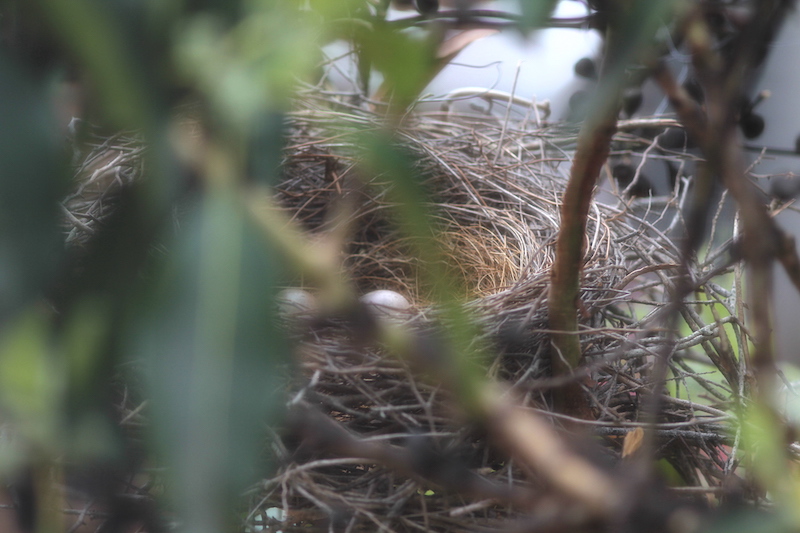
NOVEMBER 2: It’s Incubation Day 7 now, and the evil cuckoos have stayed away so far. …But then around 8:30pm I heard a murderous screech in the tree, and I looked out the window just in time to see something around the size of the cuckoo flapping over the currawongs’ nest before flying away. It was so dark I couldn’t see what it was, and I feared one of the cuckoos might have just executed a night raid on the nest.
The next morning, I half expected to see a wounded or dead currawong in the nest… but I was massively relieved when I saw the female bird nonchalantly sitting in the nest as if nothing had happened. …Then I recalled that flying foxes were recently coming to the tree at night to suck on its flowers, and one of them must have gotten too close to the nest. Currawongs are known to attack fruit bats, so what I witnessed last night must have been a hapless flying fox getting the hell out of harm’s way.
After this incident, scared flying foxes have stopped coming to the tree, and if a brave one decides to take the risk, it does so discreetly without making noise. Now, this has had an unexpected benefit for me as well. This time last year, nocturnal flying foxes came en masse for an absolute feast in the tree, making loud noise which kept me awake at night. But that’s not going to happen this year… as poor fruit bats have now lost one of their premium dining spots!

FIRST CHICK HATCHED OUT!
NOVEMBER 17: Today’s the D-Day (‘Due Day’, that is). It’s been three weeks since the female currawong laid her first egg. She is rather restless all morning – and so am I – as the cuckoos’ ominous calls can be heard in the neighborhood. It’s a very windy day with a thunderstorm forecast in the evening, and the nest is swaying like a ship sailing in a stormy sea – which makes me even more anxious. But then in the afternoon, I was able to confirm a tiny, naked chick in the nest. Congratulations to the currawong couple… you are Mom and Dad again!
Mom is seen delicately feeding her little first-born with tiny bits of food. She’s a good mom, very attentive to her chick. At this stage she’s doing most of the feeding, and when she comes back to feed her chick, she makes a soft call to it, and the chick responds with a wide-open mouth – but making no sounds yet. But I haven’t seen Dad around all day. It’s a pity she has a rather lazy husband (well, who doesn’t?). I just hope he’s not going to leave his partner as a single mother…

NOVEMBER 19: It’s the third day since the first chick hatched out, and I can see the remaining egg sort of ‘rolling’ in the nest. Mom is keeping a close eye on it, while Dad is visiting the nest with food more frequently. Looks like he’s taken his responsibility a bit more seriously now, with a few tiny mouths to feed. When I take photos of them, the parents are totally unfazed – a far cry from their hostile attitude towards me this time last year – and they don’t even bat an eyelid. (But then I’ve never seen a currawong blink its yellow eyes, ever!)

NOVEMBER 21: It’s been four days since the first chick arrived, and I’ve now confirmed two chicks in the nest. But the third egg is… well, still egg, and there’s no sign of it hatching. Occasionally, Mom looks in the nest and makes a cooing sound as if to encourage the unborn chick: “What’s taking you so long? Now, don’t be shy and come out of your shell…” (Well, literally!)
But this was the last day I ever saw the egg in the nest, and I have no idea what has become of it after that. Perhaps it was a ‘dead egg’ (unfertilized egg) – or the chick didn’t survive past hatching. In the following days, Mom’s cooing calls became low, sounding more like mourning the death of her child. How sad…

NOVEMBER 24: The two surviving chicks are thriving and growing fast. They are all mouths, these little fellas, and Dad is also kept busy feeding the chicks directly now. Inside the ‘bowl’ is squeaky clean: after feeding their chicks, Mom (or Dad) stays on the rim of the nest to see if they need to poo and takes any droppings out of the nest. Currawongs are very efficient in housekeeping, too!

UH-OH… DOUBLE TROUBLE?!
DECEMBER 4: The chicks are now becoming too big to fit underneath Mom’s belly. If it’s raining, then Mom would sit on them to provide shelter – but otherwise they are largely left alone in the nest. One of them is particularly robust and has developed a penchant for hanging out on the edge of the nest. The chicks are growing into fluffy bundles of feathers now but, worryingly, they are tan in color and not black as currawong chicks should be. At two-and-a-half weeks of age, they are already half the size of their parents and resembling the Cuckoo Kid Ver.1 from two years ago by the day… and there’s TWO of them in the nest! Well, I have a very bad feeling about this…

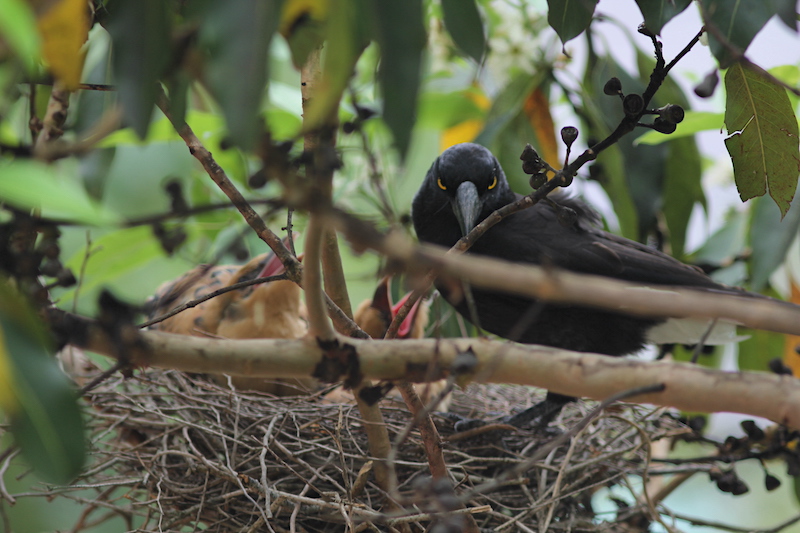
Meanwhile, the currawong parents’ cat-and-mouse chase with the cuckoo pair continues on a daily basis. The cuckoos frequently appear in the trees about two blocks away, and agitated Mom and Dad would try and chase them out of the territory. As far as I know, the cuckoos haven’t returned to the currawongs’ nest site since the first egg was laid. But if the chicks in the nest are indeed Cuckoo Kids Ver.2.1 and 2.2, then there’s no reason for them to come back to the tree, for their mission has already been accomplished!
DECEMBER 10: … Or so I thought. This morning, at 6:30am, a wild commotion broke out right outside my bedroom window, as one of the cuckoos turned up in the currawongs’ tree. Perhaps it wanted to check on its biological children. The currawong pair went berserk at this sight and began a vicious attack on the intruder, launching themselves in a kamikaze-style charge. With the small but aggressive noisy miners joining in, it soon escalated into an all-in war. The cuckoo wasn’t leaving easily this time, though, and this epic Battle Royale lasted on and off for more than three hours before the cuckoo finally flew away.
Upon hearing their currawong parents’ alarm calls, the chicks instantly froze and stayed utterly still, with one of them assuming an alert posture on the edge of the nest, while the other just shrank into the bowl in an attempt to hide itself, like a turtle retracting its head into its shell. And they remained that way until the battle was finally over. Following this almighty struggle, an exhausted Mom was seen perched on a branch in a state of stupor, while Dad was still trying to warn the cuckoo off their territory a couple of blocks away.
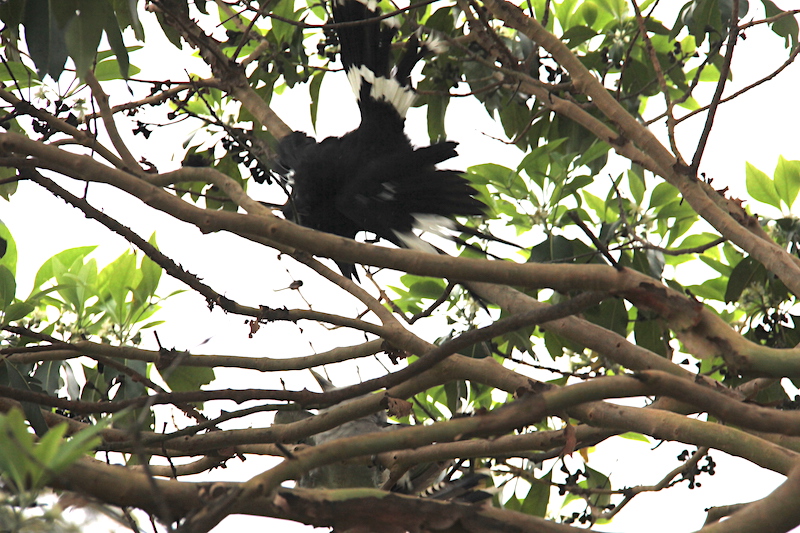
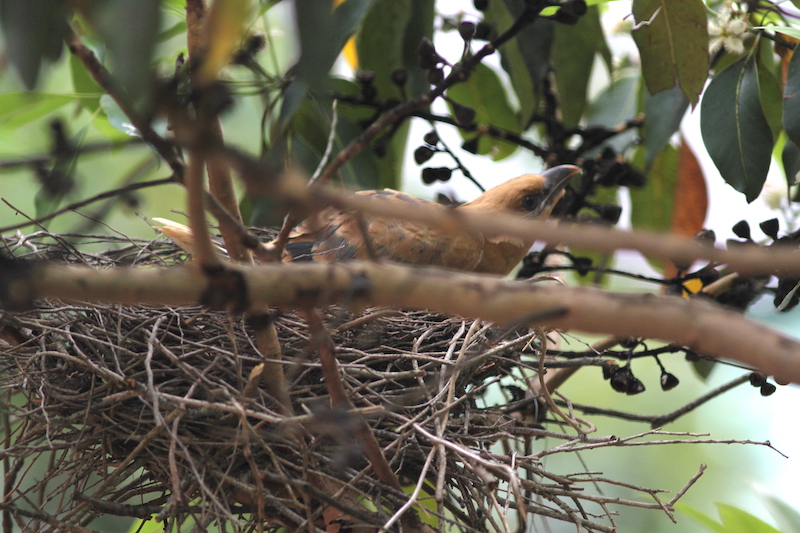
While Mom and Dad were preoccupied with shooing the cuckoo away, the poor chicks were left with no feed at all. With their breakfast session interrupted earlier, they must have been starving in the end. In a way, they just witnessed their own, friendless future as grown-ups. These baby cuckoos are cute as, and it’s cruel to think they’ll grow up to be hated by just about every other bird species. Which makes me wonder: who’s better off in the end – gullible currawongs, or despised cuckoos?
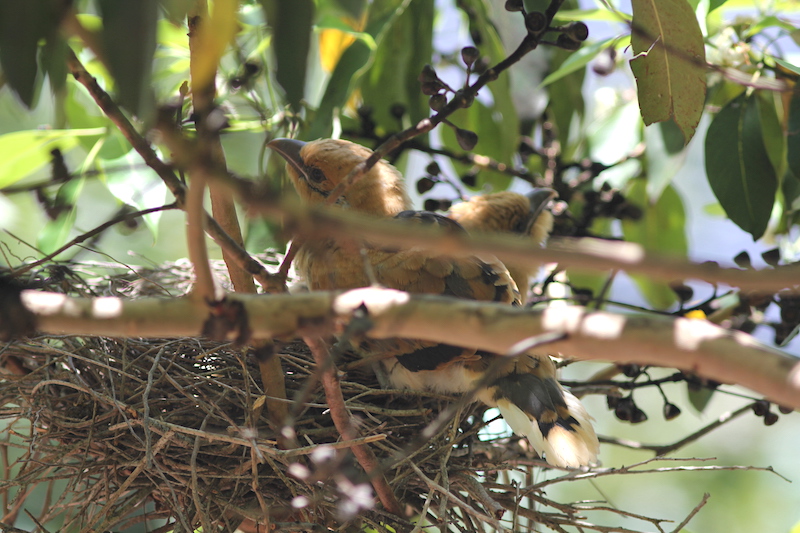
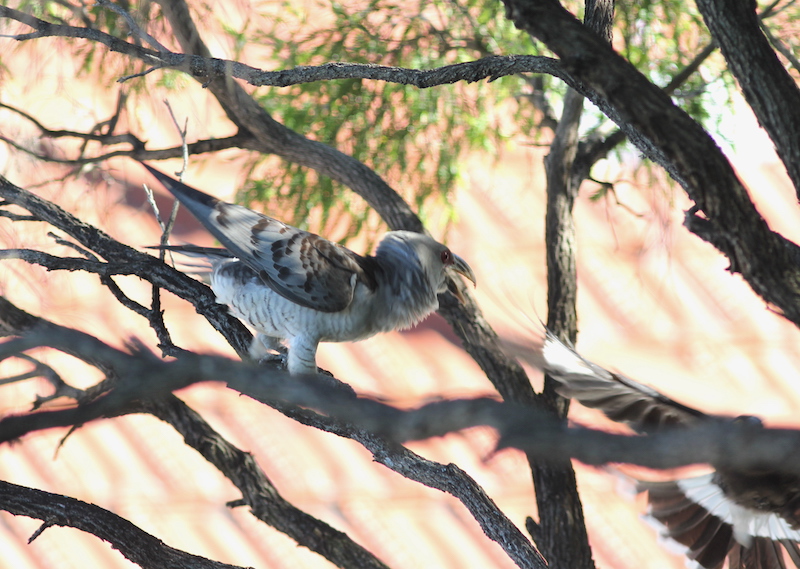
“I’m flying, Jack!” (Well, sort of…)
DECEMBER 17: The chicks are just one month old now. I can see they are tempted to ‘fly’, restlessly hopping around on the rim of the nest, but not quite confident to jump out of it. They screech while flapping their wings, which somehow reminds me of Kate Winslet in that scene on the bow of the Titanic: “I’m flying, Jack!”
The bigger chick is now venturing onto a little twig sticking out from the nest, as if to get away from its annoying sibling. They are not exactly hostile to each other but, unlike the two chummy currawong babies from last summer, there’s no display of affection whatsoever between these Cuckoo Kids. They are there together by default, and you’d get the impression that they simply accept each other’s presence – no more, no less. Perhaps they only see each other as rivals competing for food!

The food fight between the siblings is fierce. One month on, these ‘babies’ are nearly the size of their foster parents, and they are so in-your-face when begging for food that Mom and Dad are quite taken aback with their pushy attitude. The currawong parents were having a hard enough time feeding just the one Cuckoo Kid two years ago. It’s interesting to see how they would cope with two Cuckoo Kids this time around…
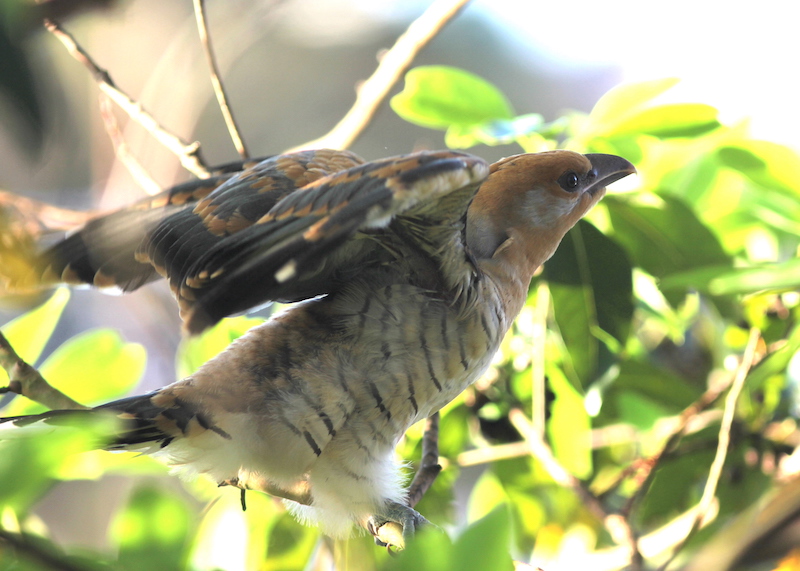
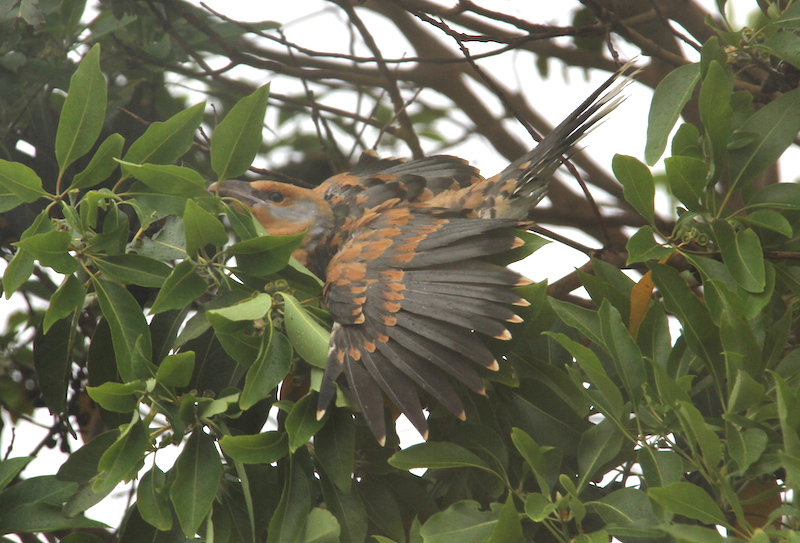

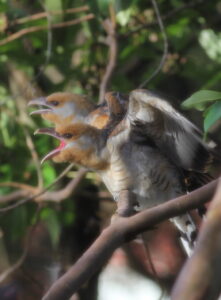
ASK, AND YOU SHALL RECEIVE
DECEMBER 19: Today marks an important milestone for the Cuckoo Kids: they have officially graduated from nestlings to branchlings. When I returned from work, the two chicks were nowhere to be seen – but their loud screeching suggested they were somewhere in the foliage of the tree. Eventually, I found one of them hiding in the leaves just above the nest, while the other, more adventurous one was right near the treetop farthest from the nest. Still unable to fly, they are hopping from branch to branch and exploring the tree. Their voices are also ‘breaking’ into that swan-like ‘I’m hungry!’ call I first heard from the Cuckoo Kid Ver.1 two years back. It’s not dissimilar to magpie chick’s begging call, but it’s ten times louder!
Interestingly, the parents seem to favor the one that screeches the loudest, and the quieter one can be left without feed for quite some time. When being fed, though, both scream so desperately that you’d think someone is being murdered in the tree…!
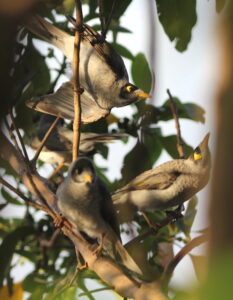
DECEMBER 29: There was a comical scene early this morning. The six-week-old Cuckoo Kids had begun flying in earnest the previous day, managing to reach the avocado tree about 10 meters away. Now, this morning, one of the chicks flew over the roof of a neighboring house and landed awkwardly on a tree – and this triggered a wild chorus of alarm calls, not just from the noisy miner family nearby but also from the currawong parents themselves: they all mistook the chick for an adult cuckoo! Upon realizing this ‘invader’ was their own chick, a confused currawong parent stayed a few paces back and looked at it – and I could almost see a speech bubble coming out:
“Who the bloody hell are you really…?”
Nevertheless, Mom and Dad still loyally keep feeding them. Which is lucky for the Cuckoo Kids. Looking at the currawong parents’ (literally) blind devotion, you’d get the impression that they are only focusing on the chicks’ mouths and not at all paying attention to their whole appearance…
The chicks are now bigger than their surrogate parents, and the way they demand food is bordering on violence, with body-slamming and headbutting their common modus operandi. In human society, they would be charged with domestic violence and slapped with Apprehended Violence Orders, for sure!
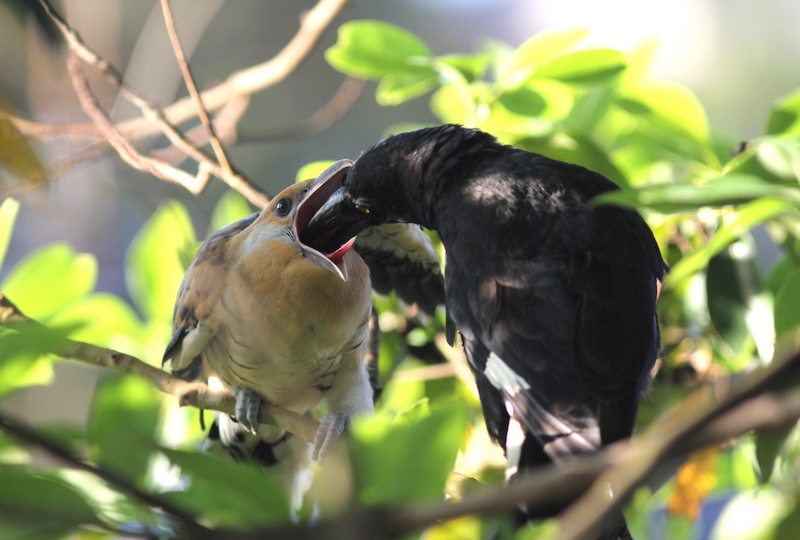

AU REVOIR… SEE YOU AGAIN IN SPRING
JANUARY 2, 2025: Another milestone on this day: one of the Cuckoo Kids has vanished, leaving the other chick home alone. Its departure was just as abrupt as that of the Cuckoo Kid Ver.1 two years ago. But then I heard a faint call in the evening, which sounded like coming from a street away. After a walk around the neighborhood the following day, I’ve found out the chick has moved on to a large tree with dense foliage a block down. The other chick remains home, though, and the currawong parents are now flying in different directions to satisfy the two hungry chicks!
JANUARY 5: The ‘homebody’ chick stayed on for another three days before it, too, uttered a determined grunt and flew away. While I can still hear the Cuckoo Kids’ begging calls in the distance, my mornings are quiet and peaceful again, as I no longer need to deal with the loud screeching well before 6am.
In a couple of months, the Cuckoo Kids will be strong enough to set out on a long journey to New Guinea or Indonesia – before coming back to their birthplace and harass their own ‘parents’ the next breeding season. When it comes to their own reproduction, our resident currawongs don’t have a good report card, failing to raise their own chicks two out of the past three years. At this rate, the cuckoo population in the area would multiply in no time and the currawongs would be fighting a losing battle. Let’s just see what happens next year, eh?
Main image: Female currawong sitting in the nest
